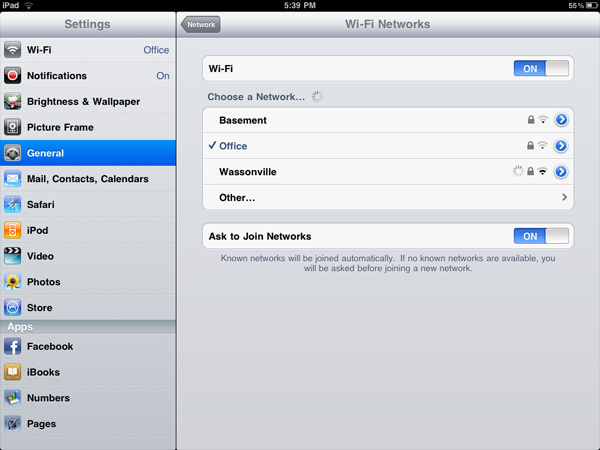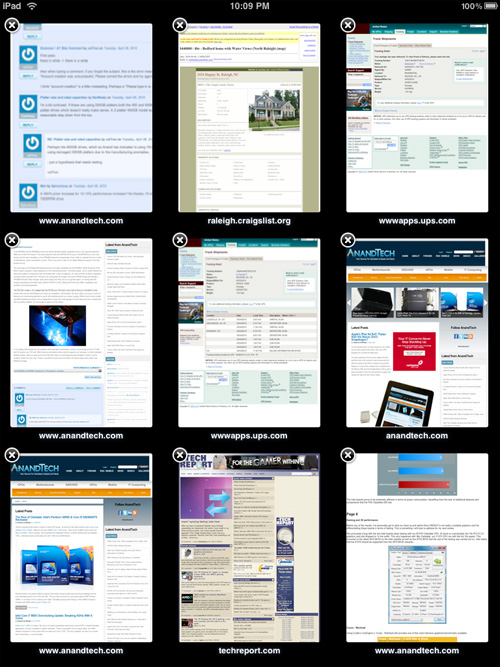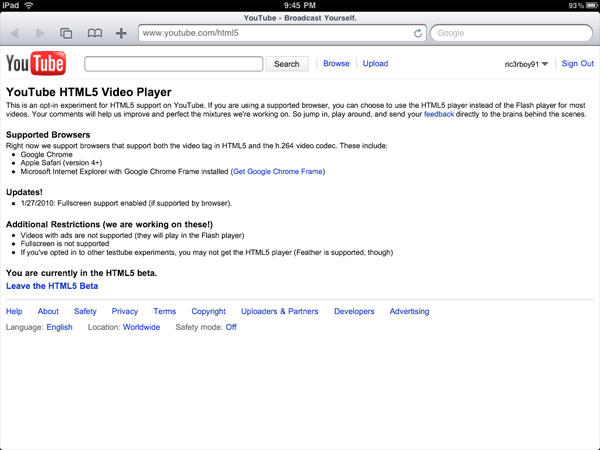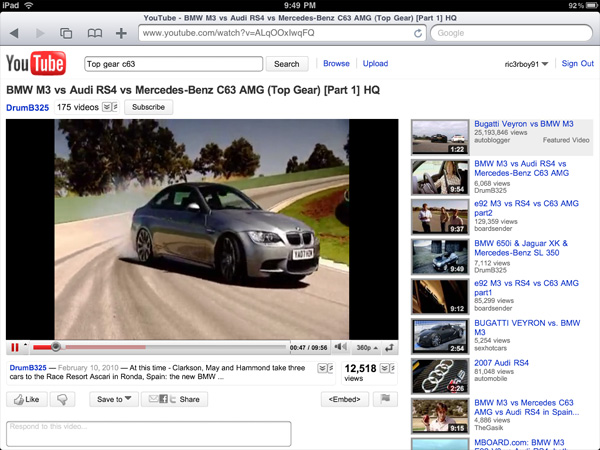Apple's iPad - The AnandTech Review
by Anand Lal Shimpi, Brian Klug & Vivek Gowri on April 7, 2010 9:39 PM EST- Posted in
- Smartphones
- Mac
- Apple
- iPad
- Mobile
WiFi
Many iPad users have been complaining about poor WiFi performance. What I have seen is the iPad doesn't seem to like to let go of a poorly performing access point in favor of another known access point with much better signal strength. Apple indicates that the iPad may not rejoin a known dual-band access point after coming out of sleep. I'm not sure whether my issue falls under Apple's KB article or not because the iPad will join my other networks, it just doesn't pick them as aggressively as I'd like.

Which one of these would you choose?
I've seen smartphones do this as well and it is a problem on my MacBook Pro. The more mobile the device however, the more annoying poorly calculated handoff timing is. Not to mention that because the iPad runs the same OS as the iPhone, there's no way to quickly switch between WiFi access points from the home screen.
The Killer App - Web Browsing
Reading web pages on the iPad is great. The 4:3 aspect ratio gives you a nice column for text heavy websites and landscape mode works well for wider layouts. It's a great tool for browsing the web and sharing what you find with others sitting around you. I can even see it being perfect for web designers working on building websites together.

Navigation is wonderful thanks to the touch screen and web sites look gorgeous thanks to the pricey LCD. Scrolling is super smooth, and it’s so much more comfortable reading articles away from a desk or without the added bulk of a laptop. It’s relaxed computing.
I'm a bit torn on this one because although I love browsing on the iPad, I'm not a fan of using it to write lengthy responses to comments on AnandTech. Quick responses are fine, it’s the longer ones that I don’t like drafting on the iPad. What I usually end up doing is reading the comments on the iPad and responding to them from my desktop. Did I mention that the iPad was a luxury?

Tabbed browsing isn't supported but you can have multiple browsers and slowly switch between them
The difference in screen size and resolution between the iPad and iPhone really makes itself felt inside Safari. Where in the iPhone you end up in stripped down mobile versions of websites, the iPad is capable of displaying a regular webpage in full-fledged glory. And because of the processing horsepower in the A4 SoC, the iPad has no problems rendering these full pages (more on this later). Part of the reason is because processor-heavy Flash objects are skipped over entirely, but doing so keeps the browsing experience fluid, which is arguably more important in a device like this.
So how does the iPad deal with content-rich sites that depend on mixed media elements? It's mixed, but overall pretty well. Pages like the new AnandTech, Autoblog, and Engadget are perfect, with the exception of the blank space wherever there should be embedded Flash objects. (There's no more blue Lego of Flash as there is on the iPhone to let you know when you're missing out.) Things get more interesting when you start hitting HTML5 video-enabled websites.

One of the first things I tried was the YouTube HTML5 beta. Yes, I know there's a YouTube app, but it's always nice to know that you can get the desktop version of YouTube working in Safari. Except, it isn't quite that simple. Reading through the HTML5 Beta page, there's one line that makes all the difference: "Videos with ads are not supported (they will play in the Flash player)." Which essentially means, if you ever want to watch an official music video or movie trailer (almost all of them have ads), you're hosed. Stick to the more off the road stuff (old Top Gear clips and various Indian music videos are good bets) and you should be okay, but it remains kind of annoying to go to a video page and be greeted with an empty hole where the video should have been. I'm hoping that Google will recognize the potential of a browser-based YouTube and disable ads when viewing on the iPad, but that remains to be seen.

Sites built around HTML5 video (or recently converted to HTML5 video in the run up to the iPad launch) work as advertised. ESPN has made the switch, and I was impressed at how seamlessly the experience translated from a normal computer. The New York Times also uses HTML5 video on their website, and it behaves just as it would in a desktop browser.

As far as social networking and communication websites go, the classic versions of Facebook, Twitter, and the Google web app suite all work to varying degrees. Twitter has a fairly simple desktop interface which translates over to the iPad flawlessly. Facebook functions well, though some of the buttons are a bit small. Also, the photo uploader doesn't work on the iPad, and while Facebook Chat does work, it remains fixed on the page, even if you scroll down. Nonetheless, it's far better than the touch optimized version of Facebook on the iPhone. It will be interesting to see how the Facebook developers utilize the extra screen space when creating the Facebook for iPad application. If it behaves like a slightly more touch optimized version of the full Facebook (instead of the icon-based iPhone app), it has the potential to be very user-friendly.

Google is another story entirely. For Gmail users, the iPad-optimized version of Gmail is awesome - you get the same dual pane message view like the Mail app, but with Gmail's signature threaded messaging included.

Google Docs is also optimized for iPad viewing. Note - viewing, not editing. There is no way as of yet to open a document in the desktop view, so it isn't possible to edit or create a new document. Highly disappointing, since full Google Docs compatibility would have been a killer feature on the iPad. If Google sees fit to rectify this problem by adding a mode to open a document in desktop view (and thus retain the ability to edit a document), it will be great. Google Talk Mobile is the same as on iPhone, except bigger, so you end up with a lot of wasted screen space. iGoogle Mobile is again the same as on iPhone, except larger, but switching to the desktop version of iGoogle fixes that problem. Some of the more advanced Google gadgets don't work, but the Gmail and RSS feeds work, as does the Weather gadget. The Google Chat sidebar makes it tempting to use the IM feature, but the experience is sadly broken. The chat windows are, like Facebook Chat, fixed on the page, and the text sometimes gets cut off on the edge of the screen. It's not enjoyable to use, but it will work in an emergency.
Google's iPad web services overall present an optimistic picture, highlighted by the Gmail application. As iPad-specific optimization finds its way to the other web apps, the Google suite could prove to be a valuable feature in the iPad. While web-consumption is a highlight of the iPad, interactive Web 2.0 sites do need work on the developer side to showcase the true capabilities of the platform. Full fledged web-browsing on the iPad ends up painting a similar picture to the rest of the device - there's a lot of potential in the device waiting to be tapped by continued development of the platform.










108 Comments
View All Comments
TGressus - Thursday, April 8, 2010 - link
"I don't think anything anyone can write can convince you"That's a tough sell right there :( Nothing against your post.
This is the challenge all tablets have faced so far. That said, if anyone has the ability to succeed in this form factor it's the iCult.
Mike1111 - Thursday, April 8, 2010 - link
"While I realize that Atom hasn't been suited for such an application until now, there's no reason Apple should've picked the A4 over Moorestown. "I really think it was the right decision for Apple to go with ARM for the iPad, and that it's the right decision to stick with ARM for at least the next few years.
(1) Mobile version of Moorestown is not available yet, the netbook one draws too much power
(2) Apple has to use ARM in it's iPhone and iPod touch for the next few years, so for cross-device OS, app and SoC compatibility and development ARM was the right choice for the iPad (e.g. if Apple makes safari use the hardware better on the iPad, the iPhone and iPod touch will directly profit from it too)
(3) Moorestown would have been more expensive
(4) With ARM Apple can control and modify the CPU design as needed, they have total control. And Apple likes that.
(5a) There is a clear upgrade path for ARM with the Cortex-A9 and a multi-core version of it.
(5b) The A4 is already fast enough for most people and most iPad tasks (how many reviews mention that the iPad is unpleasantly slow, even for the average consumer?)
It's a real possibility that an iPad with a more optimized OS and safari, a better utilized (and more programmable) GPU (like the SGX545 with OpenCL etc.) and a dual-core Cortex-A9 @1.x GHz will improve the browsing performance beyond that of a netbook. And IF APPLE SAW THE NEED FOR IT (but I don't think they do), it could happen as early as next year (other ARM SoCs like Tegra2, OMAP4 and the dual-core Snapdragon will be available by then with comparable specs, so Apple should be able to pull it off too). Intel's Atom will still be a more power consuming, more expensive and way bigger multi-chip system early next year. And beyond that are ARM quad-core CPUs and dual-core GPUs...
It will take Atom at least 4 years to overtake ARM, in the areas that count for dedicated smartphones/slates/tablets, if at all. At some point, real life browsing will just be fast enough on an ARM slate and Intel netbook, so that 99% don't care about browsing speed as a feature anymore (like it will happen with video thanks to all these powerful but small dedicated decoders/encoders like IMG's VXD/VXE).
softdrinkviking - Thursday, April 8, 2010 - link
are you saying that there is no clear upgrade path for intel's moorstown line?and that apple has complete control over the future of ARM?
i didn't know they had already gone that far.
i seem to remember apple fumbling out of the power series of CPUs and crawling into into intel's arms when they realized it was the way to go.
there is nothing to prevent apple from switching to moorstown in a couple of generations, and they have proven that they are willing to make those kind of changes when the situation demands it.
Mike1111 - Friday, April 9, 2010 - link
"are you saying that there is no clear upgrade path for intel's moorstown line?"Of course not. I'm just saying that even if you think the ARM Cortex-A8 used in the iPad is not powerful enough, that there are clear CPU upgrades coming your way for years to come (higher frequencies, Cortex-A9, dual-core Cortex-A9, quad-core Cortex-A9). It's not like Apple is using a quad-core Cortex-A9 @ 4 GHz in 22nm right now, with no better ARM architecture on the horizon and standard lithography reaching a dead end...
"and that apple has complete control over the future of ARM? i didn't know they had already gone that far."
Sorry, what I meant was that Apple has complete control over how they implement the ARMv7 architecture in a chip (since Apple has most likely an architecture license like Qualcomm).
"there is nothing to prevent apple from switching to moorstown in a couple of generations, and they have proven that they are willing to make those kind of changes when the situation demands it."
I agree that Apple can and most likely will switch to Intel if their chips are clearly superior in all the ways that matter for a mobile product. I just think that's at least 4-5 years out for retail devices so there's no point in talking about how Apple should have used Moorestown for this year's iPad... or any iPad for that matter. I don't even think that Moorestown's successor will be ready (Medfield). Maybe Medfield's successor's successor in 22nm will be clearly superior (although parity could be reached a generation earlier). We'll see.
MadAd - Thursday, April 8, 2010 - link
Its huge. Way too big for car centre consoles. If they cut it in half, so its mid way between that and an Iphone then I would definitely want to upgrade my existing car PC.Its got all the right airs and graces to be a super satnav/speedcam/music/incar wifi unit, just need to cut the size and sell it with some kind of some kind of quick release device for power and cabling (or ill fabricate one) and its a winner.
teng029 - Thursday, April 8, 2010 - link
"Companies like Crestron and AMX supply ridiculously poor touch screen interfaces to their very expensive home automation installations."How exactly did you come to this conclusion? Have you extensively either used or program a control system touch panel?
Anand Lal Shimpi - Thursday, April 8, 2010 - link
Used, but not programmed. Those touchscreen controllers are just not in the same league in terms of UI as the iPad/iPhone honestly. I haven't used the latest incarnations but from the looks of them, they haven't changed tremendously.Take care,
Anand
athreya - Thursday, April 8, 2010 - link
1. Does writepad (phatware) or sketchbook pro (autodesk) allow one to take handwritten notes on the ipad? As in, im not looking for handwriting conversion to pages or word but can notes be taken and emailed across in the body of say a gmail or a Mail message? WHich stylus is the best for the ipad?2. How do you think iphone os 4.0 will solve the multitasking problem?
3. Between the wireless keyboard and the keyboard with dock which would you recommend and why? Will ANY BT keyboard work with the ipad?
4. Can you tell us how good it is at projecting powerpoint ppts onto a standard VGA projector? Does it support Office for Mac yet?
thanks a lot Anand. Terrific balanced review as always.
strikeback03 - Friday, April 9, 2010 - link
I doubt any stylus works with the iPad, due to the capacitive screen.dagamer34 - Friday, April 9, 2010 - link
A capacitive stylus would work.